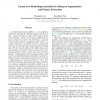Free Online Productivity Tools
i2Speak
i2Symbol
i2OCR
iTex2Img
iWeb2Print
iWeb2Shot
i2Type
iPdf2Split
iPdf2Merge
i2Bopomofo
i2Arabic
i2Style
i2Image
i2PDF
iLatex2Rtf
Sci2ools
ICCV
2011
IEEE
2011
IEEE
Latent Low-Rank Representation for Subspace Segmentation and Feature Extraction
Low-Rank Representation (LRR) [16, 17] is an effective method for exploring the multiple subspace structures of data. Usually, the observed data matrix itself is chosen as the dictionary, which is a key aspect of LRR. However, such a strategy may depress the performance, especially when the observations are insufficient and/or grossly corrupted. In this paper we therefore propose to construct the dictionary by using both observed and unobserved, hidden data. We show that the effects of the hidden data can be approximately recovered by solving a nuclear norm minimization problem, which is convex and can be solved efficiently. The formulation of the proposed method, called Latent Low-Rank Representation (LatLRR), seamlessly integrates subspace segmentation and feature extraction into a unified framework, and thus provides us with a solution for both subspace segmentation and feature extraction. As a subspace segmentation algorithm, LatLRR is an enhanced version of LRR and outperforms...
Computer Vision | Data Matrix | ICCV 2011 | Segmentation Algorithm | Unsupervised Feature Extraction |
| Added | 11 Dec 2011 |
| Updated | 11 Dec 2011 |
| Type | Journal |
| Year | 2011 |
| Where | ICCV |
| Authors | Guangcan Liu, Shuicheng Yan |
Comments (0)

